A lot of you may not know this, but non-reef safe sunscreen is actually illegal in the USVI. In July of 2019, legislation was passed in the territory outlawing the sale and usage of sunscreen that is harmful to the marine life, and potentially harmful to you! The ban went into effect in March of 2020 and, well, there was kind of a lot of other things going on at the time that prevented it from getting proper coverage (pun intended) or enforcement. Ahem, COVID.
Unfortunately, the term “reef friendly” is not regulated, so it is easy to get confused about what is “safe” and what isn’t. I know that I have been swindled in the store while purchasing sunscreen I thought to be reef safe, only to get home and take a closer look at the ingredients to find that my spendy sunblock purchase had been in vain! I did a little digging to come up with a list of the no no ingredients and “safe” brands to look for so that you can make sure the same thing doesn’t happen to you!

First off, always check the ingredients before tossing that “reef friendly” sunscreen into your shopping cart…Virtually or otherwise. The big ones to look out for are the Toxic Three O’s:
- Oxybenzone
- Octinoxate
- Octocrylene
If the sunscreen you are pondering has any of these on the active ingredients list on the back of the tube, place it back on the shelf and keep browsing. A few other notable no no ingredients that may be a bit less common but should still be avoided are:
- Homosalate
- 4-methylbenzylidene camphor
- PABA
- Parabens
- Triclosan
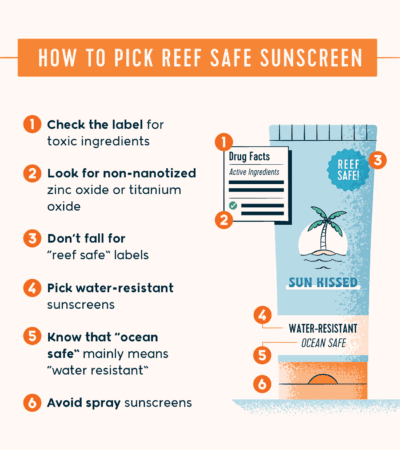
In addition to avoiding the above chemicals, steer clear of spray sunscreen! I understand that it is much easier to apply on the go, especially if you are already at the beach. But, no matter how good your aim might be, some of that spray is likely going to wind up in the sand and, eventually, into the sea. And don’t EVER let a captain see you with spray sunscreen on their boat! We had some guests on board Asante a while back who had “reef friendly” spray which they had applied earlier in the day. And it came off of their skin while on board and turned the boat ORANGE. Spray sunscreen can be sneakily tinted apparently…and if it is turning the boat orange, I surely don’t want it on my skin 🙂
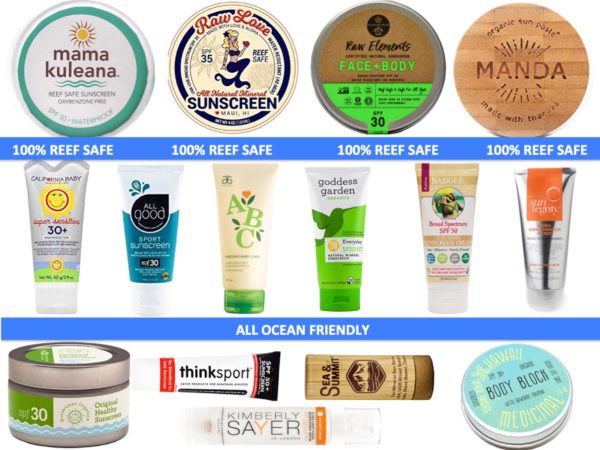
Zinc Oxide and Titanium Dioxide are the active ingredients you want to see printed on that label when you flip the bottle over. Here’s the difference: The above no no ingredients are chemicals that absorb the sun’s rays and turn it into heat that is then released from the skin. Zinc and Titanium Dioxide actually form a physical block that prevents your skin from absorbing the sun.
I know, I know….the next words out of your mouth are “But they don’t rub in!” I’ll agree that it’s super annoying when you feel like you need to look like Casper the Ghost in order to safely protect your skin from the sun. But, there’s been a TON of research done over the years and I have actually happened upon a few choice brands that both saturate your skin AND keep the reefs safe from toxic chemicals.
Think Sport
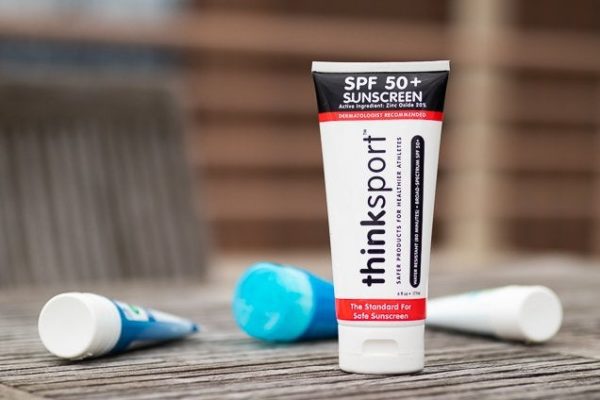
It absorbs better than most and doesn’t feel greasy, it’s waterproof AND it’s easy on your wallet. You can get a six ounce tube of SPF 50 for $22 on Amazon ($3.66 per ounce). If you’re traveling light, they also sell three ounce sized bottles that are perfect for your carry on. The primary ingredient in Think Sport sunscreen is non-nano zinc which, in the US, is considered the most reef friendly active ingredient on the market. As with any sunscreen with zinc, you’re going to notice a white cast after application. But, hey, at least you can see where and when you need to reapply!
Think Sport is also available in “kids” and “baby” formulas, but don’t be fooled by the label. The only difference between the three is the fragrance. So, the original and the variants are all safe for both mama and baby.
BeautyCounter Counter Sun Mineral Sunscreen
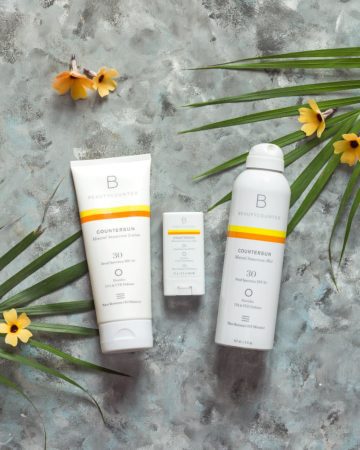
This one is going to be a bit rougher on your pocket book, ringing in at $39 for a 6.7 ounce tube ($5.82 per ounce). But, there are a lot of natural additives in Counter Sun that makes your skin super happy! The active ingredient is, once again, zinc oxide but add to that mix a little California Poppy, natural citrus and peppermint oils and you’ll get a lovely smell with happy skin and great sun protection.
Counter Sun is water resistant for up to forty minutes, which does make for more applications, but if you have been on the hunt for a great feeling facial sunscreen, this is it. And, this one WILL NOT leave that pasty white shadow on your skin!
Badger Sport Mineral Sunscreen

This one is the pick for water sports enthusiasts. The active ingredient is uncoated zinc oxide with a list of inactive ingredients that you can recognize…and pronounce! Jojoba oil, sunflower oil, beeswax and vitamin E come together to nourish your skin while you responsibly protect it. An added bonus is that it is 98% organic AND the zinc oxide formula is clear! So you’re guaranteed a smooth and Casper free application. It is also water resistant for up to 80 minutes and middle of the road as far as cost goes. So, less applications plus average cost equals the most bang for your buck. A three ounce tube of 35 SPF is about $13 at Thrive Market ($4.41 per ounce).
A few brands to watch out for unfortunately…
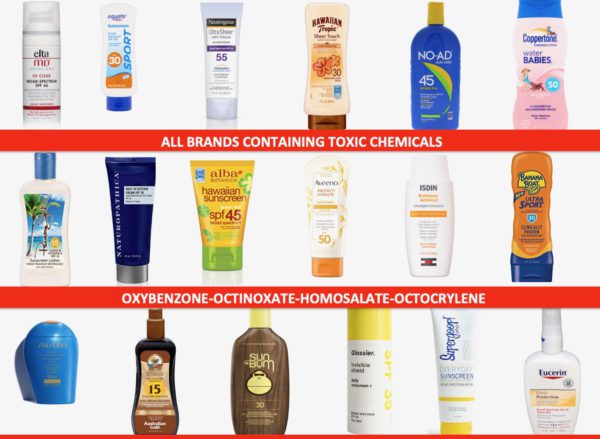
Sun Bum was my absolute favorite reef safe sunscreen…Until I educated myself a bit and realized that it actually isn’t! It is advertised as reef safe, paraben free and vegan, but it contains octocrylene in its list of active ingredients. It’s smooth application and delicious Hawaiian Tropics smell made me LOVE it, but, alas, another bottle lands in the bag of “pool only” sunscreens. I’ve been duped by other sunscreens with the reef safe label to be sure, but I mention this one specifically because it really broke my heart. Le Sigh.
I have had a ton of folks writing in and requesting reef safe sunscreen information and options. I hope that you all found this helpful! One final friendly word of advice is to order online or buy your sunscreen at home before traveling to the USVI. Test it out in the sunshine to test for coverage. I cannot tell you how many people get fried in the scorching Caribbean sun after using and trusting a sunscreen they had never tried out before. So, test a few products out at home to figure out what works best for you so a serious sunburn doesn’t ruin your St. John holiday 🙂
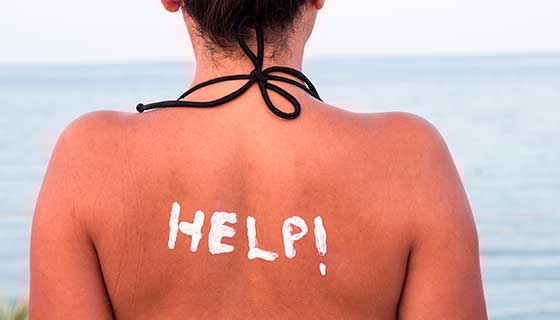


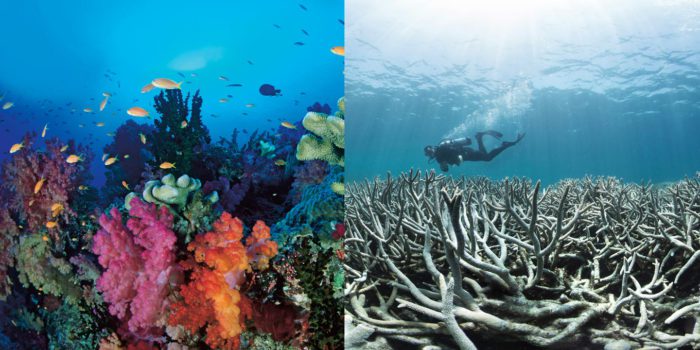
Sunbum Mineral (white packaging) is reef-safe. That’s my favorite!
We bought Bare Republic spray and lotion at one of the watersports shops in Cruz Bay a few weeks ago. I assumed it was reef safe, otherwise they wouldn’t be able to sell it?
Thank you for this great info. I had been fooled by some of the “reef safe” sunscreens too. I do not like it when I apply the zinc and then walk around “ghostly”. I have been using the Badger clear zinc that you mentioned and have come to love it. I used to think that a 30+ sunscreen would not allow me to get a tan but I’ve found this sunscreen to give me a great tan that lasts rather than peeling off due to a burn. Thanks again!
Good afternoon, please fix misinformation in this post, as the banned ingredients are not allowed in pools in the USVI.
The law states “use or possess….while in the Virgin Islands.” The ban isn’t just for beach use, but for any use within the USVI. The toxic chemicals will find their way into the ocean, regardless of where you use them.
You can find the law here:
https://www.legvi.org/billtracking/ShowPDF.aspx?num=8185&type=Act
Thank you, Hillary!. THAT was a very HELPFUL article. It would be great if Villa Management would include in their booking paperwork so folks know ahead of time.
I’ve mentioned to deaf ears that the Reef Safe Announcement from Port Authority on the ferry ticket office as you line up to buy tickets to LEAVE would have been better-placed at Airport along the line from tarmac arrival to terminal entrance as people arrive. But understanding and buying before packing is the BEST solution for all.
Good afternoon Hillary,
I make Virgin Elements; locally sourced reef safe suncare products including reef safe spf 30 balms and lotions, shampoo, conditioner, body wash, and locally sourced salt scrub from virgin island salt! I would love to share my products with you and help spread the love!
Virgin Elements: reef safe suncare reinvented
Hi Alesha!
We recently traveled to bvi and our captain stocked your products. They’re fantastic. We’d really like to place an order but I can’t seem to find your contact info anywhere. I’d love to get in touch!
I used your product on a charter trip – where can I order some? Loved it!
Great article! I had to share it!
Thank you so much for an informative post! I have trusted the “reef safe” label knowing in the back of my mind that the label wasn’t regulated.
I just placed an Amazon order for the Badger reef safe sunscreen which everyone in my family will get as stocking stuffers for our 2022 trips to St. John.
Alesha, where do you sell your suncare products?
Badger Clear Zinc Sport: I looked for it on Amazon – and it was $25+ for a 3oz tube! But hot tip: target.com has it at a much more reasonable cost of about $15/tube. Free shipping if you have a target card and it might also be available at a Target near you.
My question is about spray sunscreen. If it is reef safe, is it allowed? (Not bringing to the beach, just spray on before leaving the villa.) Thanks!
Out of curiosity, how are these laws enforced among tourists? Is your luggage checked upon entering USVI? Are there patrols on the beach going through bags to look at your sunscreen bottles? I think it’s great to have these laws in place but I can’t wrap my head around what it would take to monitor the “use and possess” parts of it.
The USVI law (https://www.legvi.org/billtracking/ShowPDF.aspx?num=8185&type=Act) only refers to three ingredients; oxybenzone, octocrylene and octinoxate. Some sprays (which I’m sure are not allowed) contain none of those ingredients, but it seems that in consideration to marine life, they are (understandably) also not allowed. Can someone (maybe working for the tourist bureau) please post a list of products or ingredients that ARE allowed. You only list a few recommendations and, while that is somewhat helpful (and dare I say beneficial to the few companies represented), I would hope that we could find a bunch of other options out there. We are interested in saving the little nature we have left on Earth. Just wish it wasn’t such a jungle. Also, if this is really a thing, why are these chemicals allowed in any US states or territories?? WTH (DEET, high fructose corn syrup???) These things might sound crazy, but how can we continue to allow the production/sale of things known to be harmful? Wouldn’t it be easier if they were just banned everywhere? Cheers!
I had purchased ‘reef safe’ spray on sunscreen from Tropical Seas SPF 30 only to find it has both Oxybenzone and Octinoxate. Ugh. So I use that one at home in NJ, not in St John.
The one I’ve now purchased for travel is called BurnOut SPF 30 and it’s Zinc Oxide. I don’t think the fish care if I look a bit pasty while snorkeling… got it here on Amazon:
https://www.amazon.com/Physical-Sunscreen-Ocean-Tested-Ounce/dp/B000851N9E/ref=sr_1_5?crid=2H9B3QYI7ZEL3&keywords=burn+out+sunblock&qid=1680123456&sprefix=burn+out+%2Caps%2C222&sr=8-5